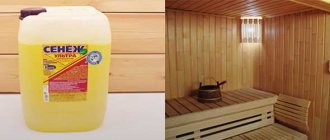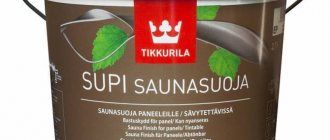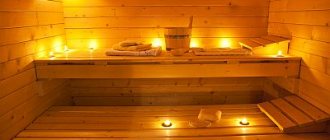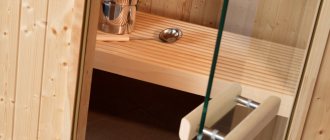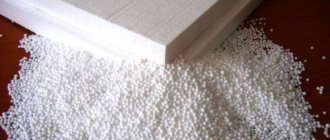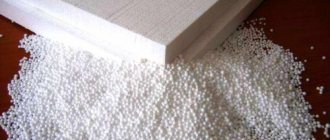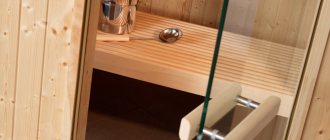Exposure to sunlight, precipitation and temperature changes does not go unnoticed: the frame of the bathhouse cracks, the appearance deteriorates, the wood is affected by fungus, and mold appears. What paint should I use to paint a wooden bathhouse in my country house to protect it from climatic stress and restore its former attractiveness?
To decide what paint to paint a wooden bathhouse at the dacha, it is necessary to take into account not only external factors, but also the functional features of the bathhouse - high humidity and temperature changes, especially large in winter. If you choose the wrong paint, the aging and destruction of wood can accelerate.
What and how to paint the inside of a bathhouse
Before answering how to paint the inside of a bathhouse, you should decide on the type of wood. The building is divided into several rooms. For example, to build a steam room, special heat-resistant wood species are used that do not release resins when heated.
Moisture-resistant wood is used for the dressing room and rest room. Most often, spruce or larch is used for interior wall decoration. Because of such nuances, painting the inside of a bathhouse has a number of its own issues: one type of paint is used to paint the floor, benches, table and lining, and special fire-retardant compounds are used to paint directly vertical surfaces.
In addition to paints, there are additionally special impregnations and varnishes. The latter are distinguished by their transparency with subtle shades, which after drying only emphasize the structure of the wood.
Moisture-resistant wood is used for the dressing room and rest room.
Proper processing of lining
Having decided how to cover the lining in the steam room of the bathhouse, you can proceed to the processing itself. To perform high-quality impregnation that will last a long time, we recommend that you read the following instructions:
- Processing lining in a steam room begins with preparing the wood itself. Clean it from various contaminants with sandpaper or other suitable method. It is also recommended to wash the boards with an aqueous solution of soda (300 g of soda per 10 liters of water);
- Next, you need to degrease the surfaces. Remember that not only the lining itself is impregnated, but also the frame to which it is attached;
- Sand surfaces with pumice to obtain a smooth finish;
- Next, you need to apply an antiseptic that will protect the wood from fungus and mold;
- Now you can saturate the paneling. When choosing impregnation for the dressing room, pay attention to the humidity of the air in it, as well as the temperature of the steam. If the indicators are approximately equal to the indicators inside the steam room, then it is necessary to use the same impregnation.
By doing all the work correctly, you can achieve an excellent result, as in the photo.
If you decide to paint wood, then you next need to decide how to paint the lining in the steam room of the bathhouse. Often, a special acrylic varnish is used for this, which can withstand high temperatures and does not release toxins, but special paint can also be used.
To paint the lining with high quality, you must follow certain rules:
- Painting of the lining is carried out in warm and dry weather.
- You can paint with a roller or brush, moving them parallel to the wood fibers so as not to leave streaks on the surface.
- Stir the paint thoroughly before applying to obtain a uniform color.
- Apply the paint in a thin layer - this will allow you to achieve the best coloring result.
Is it possible to paint the inside of a bathhouse?
Most people believe that painting the inside of the bathhouse is not necessary. However, over time, the wood begins to darken and crack, which occurs with constant exposure to high temperatures and in the absence of a proper ventilation system. The tree is then damaged by mold and other pathogens, which ultimately leads to rot.
If you do not treat surfaces with impregnations, varnishes and paints, you can get a completely environmentally friendly structure. On the other hand, you should stock up on money and time for future repairs. It is important to understand that when heated, almost any paintwork material releases particles of its chemical compounds into the atmosphere. But there are paints that are acceptable for use in steam rooms.
There are paints that are acceptable for use in steam rooms.
Types of premises
Fortunately, there are not many rooms in the bathhouse (in a standard one). Therefore, we will quickly go through the options of what paint to paint the inside of the bathhouse.
Steam room
This is the most problematic room. Many people believe that there is no need to paint anything there at all, but the price for such a decision is rapid darkening of the wood (and almost everyone has a steam room traditionally made of wood or lined with wood), cracking of the wood (this happens more often from poor ventilation during drying), susceptibility to rotting and mold damage (linden and aspen are very unstable species).
So the absence of any protective coatings, on the one hand, should be considered environmentally friendly, and on the other, costly in terms of future repairs.
You can paint the inside of the steam room with both paints and varnishes, but let them be water-soluble paints. And it would be nice if the label mentioning GOST standards stated that this composition is applicable in the steam room.
Washing
Both silicone and acrylic paints are suitable here. In general, everything that patiently endures the effects of moisture.
Other paints will crack and peel off in pieces under constant exposure to water.
ADVICE! Water dispersions do not tolerate frost well: if the water in the paint freezes, then after defrosting it will lose its quality. Therefore, buy them in the warm season, produced recently.
Impregnations and varnishes are also suitable for painting washing areas.
Again we draw your attention to scuba gear
Of course, in the second case, it is better to paint when it is possible to ensure the best ventilation and the absence of people. Don't forget to use respiratory protection.
IMPORTANT! Remember that enamels and alkyd paints are fire hazards, but water-soluble paints are not.
Types of bath paints
There are requirements for materials for finishing baths and saunas, but they are not so severe. Bath paint for interior painting on wood can be:
- Enamel;
- Water soluble;
- Oily.
When applying enamel, a dense, glassy layer of coating is obtained. Alkyd compounds are used as a base, because their compounds are toxic. The decoration process is permissible if constant ventilation is possible.
When applying enamel, a dense, glassy layer of coating is obtained.
Oil paints are a mixture of coloring particles and oils that dry quickly. Initially, drying oil was used as a base, but modern products are quite diverse and now most people use artificial drying oil based on alkyd resin. Water-soluble compositions can have different bases, acrylic, latex, polyurethane, and so on.
Oil paints are a mixture of coloring particles and oils that dry quickly.
Manufacturers
Bath paint is produced by domestic and foreign manufacturers. Its price depends on the material used and the quantity in the jar.
Belinka
The manufacturer's product range consists of paints, glazing compounds, varnishes, and impregnations. They have a wide range of colors, which allows you to bring any design idea to life. When using materials, the structure of the wood is preserved. Belinka produces polyacrylate paints that have water-repellent and vapor-permeable properties.
Tex
Paint from the Russian manufacturer Tex has protective qualities, which guarantees an increase in service life. The company produces soil and glaze antiseptics, drying oils, wax compositions, and fire-retardant impregnation. This allows you to choose an acceptable option for painting the bathhouse.
Saikos
The compositions of the German manufacturer are developed on the basis of natural oils and waxes. This ensures the preservation of the structure for many years.
Requirements for modern paints
With the development of technological progress, paints with a high degree of environmental friendliness, safety and quality have come to the fore in demand. The requirements for paints for a sauna, as well as for paints for a steam room, are no different.
After drying, the compositions should allow air to pass through well, which will help avoid the formation of condensation, which leads to the formation of mold and pathogenic fungi. Plus:
- The compounds must not decompose at elevated temperatures;
- Performing protective functions, paints should extend the service life of the material;
- Must have high decorative properties.
The paint is selected based on the technical characteristics specified by the manufacturer on the packaging.
It is advisable to give preference to water-based compositions that are well absorbed into the structure of the material. After painting, any room must be well ventilated.
After drying, the compositions should allow air to pass through well, which will help avoid the formation of condensation.
How to operate without reducing service life
Covering a country bath with clapboard will last much longer if you cover it with a special water-repellent varnish. Now you can buy one at any hardware store. The main thing is that the varnish is not toxic. Otherwise, while taking a steam bath, you can even get poisoned. And after covering, you need to let the room ventilate, settle for at least a week, and only after that you can heat the steam room.
Both drying oil and stain are suitable for protecting wood. It can be painted in any desired color. But, again, the paint should not be toxic. Ideally, not only the lining itself should be processed, but also the slats on which the master will attach it.
Features of choosing a coloring composition for a bath
The difficulty of choosing is due to temperature and humidity. The heat is much stronger in the room closer to the ceiling, and with strong heating, as mentioned earlier, coloring pigments release toxic substances into the air.
Therefore, in a steam room, it is advisable to treat the ceiling and upper part of the room with impregnations. Like paints, they differ in their composition and release form; they can be water- or oil-based.
Before purchasing, it is important to determine the area where it will be used (ceiling, floor, walls, etc.). The choice is also influenced by subsequent processing, namely, whether the surface will subsequently be covered with a decorative layer or not. The next factor is ease of application, as well as the degree of moisture protection. The optimal product is considered to have good moisture-proof and steam permeability properties.
In the steam room, it is advisable to treat the ceiling and upper part of the room with impregnations.
Briefly about the main thing
To process lining in a bathhouse, materials that are resistant to temperature changes, humidity, and washing are used.
Also important is inertness to fungus, mold, bacteria, and a safe composition for humans. When heated, many materials release toxins and other harmful substances, so the use of antiseptics, fire retardants, drying oils, varnishes with solvents and acrylic resins is unacceptable for the steam room.
For walls and ceilings, impregnations, mastics, oils and some varnishes are used. For shelves only oil or wax based formulations. This prevents the formation of a thick film to avoid burns.
Bleach is used in any room of the bathhouse, but before further processing of the wood, it is necessary to wait until the chlorine evaporates and the hydrogen peroxide decomposes.
Antiseptics and fire retardants are classified as pre-treatment agents for wood, but are not used as independent coatings. They protect the lining and help reduce the consumption of the finishing coating.
Selection of paint and varnish materials for interior work
Requirements for coating materials vary depending on the processing area. The steam room is considered the most problematic place. Oil-based coatings better penetrate deep into the natural structure of the material, prolonging its service life, but at the same time they are characterized by increased toxicity and an unpleasant odor due to the presence of solvents in their composition. They are ideal for treating the outside of walls, as well as the dressing room.
Water-soluble impregnations are suitable for this area. They are based on acrylic, and an additional component is color, which gives the surface a particular shade. This impregnation can be used to treat the structure both inside and outside. However, despite all the advantages, acrylic compositions have a significant disadvantage - over time they are washed out of the wood structure.
In order for the surface to retain its properties for as long as possible, it is necessary to paint it periodically. Another option is to apply a waterproofing compound first and only then impregnation.
How else can you paint a bathhouse inside a steam room? Instead of drying oil, you can use paraffin oil or any other composition intended directly for the steam room. This oil is distinguished by its safety for health while maintaining characteristics similar to drying oil.
In the bathhouse, surfaces are treated with impregnation several times a year.
In order for the surface to retain its properties for as long as possible, it is necessary to paint it periodically.
The least heating zone in the steam room is the floors. Therefore, the answer to the question of how to paint the floors in a steam room in a bathhouse is quite simple - any oil impregnations or acrylate compounds. For wooden floors, you can use water-based varnishes, which do not have an unpleasant odor and are much easier to apply. When choosing a water-based varnish, it is better to give preference to European manufacturers, since the quality of these particular products is much higher.
You can often find concrete flooring. This coating must be painted. Epoxy, polyurethane and acrylic mixtures are suitable for this.
For wooden floors, you can use water-based varnishes, which do not have an unpleasant odor and are much easier to apply.
Types of coatings
The wood in the bathhouse is coated with paint to reduce exposure to moisture and high temperature.
The steam room and washing room are subject to the greatest load. However, this load is different.
- In a sauna, the air temperature can rise to 110°C. However, the humidity here is low. Paint for such a room must withstand heat, but may be sensitive to water.
- In the steam room, the humidity is much higher - from 70 to 100%, depending on the type of bath. The temperature is noticeably lower – it rarely rises above 60°C. The finishing material must be resistant to both water and steam and temperature changes.
- In the washing room, the temperature is not higher than a comfortable +30°C, but the humidity here can be high - 90–100%. The paint chosen is as waterproof as possible.
In practice, painting the inside of a bathhouse, especially a log house, is not a good idea. Any paint will be less resistant to the above factors than the wood itself. But if there is no other way to protect the finish, they also resort to painting.
Oil impregnations and varnishes
Effect of oil impregnation against moisture
A bathhouse is a structure used with a certain frequency. The high temperature in the steam room is maintained only during the procedure. Then the room is specially ventilated, cooling to a low temperature.
In this mode, the boards are more likely to dry out and become covered with cracks rather than mold and rot. Therefore, oil impregnations and varnishes are best suited for treating the steam room.
The oil penetrates the top layer of the wood, forming not a film, but a structure impenetrable to water. At the same time, the wood continues to expand normally and decrease in volume as the temperature changes. This way the oil prevents cracks from appearing.
Antiseptics for bath floors
The floor in the bathhouse is covered with antiseptic impregnations against rotting.
It is not enough to paint the steam room or sauna in the bathhouse - you need to take care of protection from rotting. The weak link in this room is the floor. Water flows onto it, steam is deposited, and it comes into contact with a cold concrete base or soil. To prevent the wooden floor in the bathhouse from rotting 5-6 years after construction, it must be treated with antiseptic impregnations.
Liquids based on substances that have a disinfecting effect:
- Acrylic-based water-based compositions. Moisture-resistant, prevent the growth of fungus, but are not very effective. More suitable for processing the dressing room.
- Organic – based on oils. They are better absorbed by wood and are moisture resistant.
- Products based on wax and urethane oils are absorbed to great depth. In addition to the water- and dirt-repellent effect, they give the timber and lining velvety and softness.
- Combined compositions increase both water resistance and fire safety.
It is strictly forbidden to use compounds that release toxins when drying to treat wood.
Water-dispersed impregnations
Acrylic paints reduce the harmful effects of moisture on wood
You can paint the logs inside the sauna or steam room with water-soluble paints.
The floor and walls in the steam room are painted with water-dispersed acrylic paint. It is quite resistant to temperature changes and does not prevent the penetration of steam. The hiding power is usually low, but the wood can be given any color. The downside is its low durability, the paint washes out quite quickly.
Paint for a bathhouse in a washroom should be as resistant to water as possible. The best products are latex or polyurethane based. For a dressing room or rest room finished with plaster, you can use any compositions marked “for interior decoration.”
The paint forms a film coating on the surface of the wood. And oil compounds penetrate inside, so in the steam room the walls are treated with impregnations.
Wax-based impregnations
Wax paint does not allow moisture to pass through, so it is well suited for baths and saunas
Wax is offered in liquid - viscous composition, and solid. The latter is somewhat more difficult to apply without the habit, but the treatment is carried out less frequently. The product does not create a sticky film and does not attract dirt.
If you only need to protect surfaces from water and steam, wax is more suitable. It is transparent, does not hide the structure of the wood, has some antioxidant activity, and therefore prevents the darkening of the wood.
Water-based polyurethane varnish
This is a kind of resin solution, where water, ethanol, and ether are used as a solvent. For the bath, choose water-soluble varnishes. They are resistant to high temperatures and to acids, oils and salts.
Polyurethane varnish is wear-resistant. Since it is based on water, the varnish layer does not create increased tension on the surface of the wood, and therefore is not prone to cracking. And since the resins polymerize already during drying, there is no subsequent peeling.
Surface preparation and painting process
Whatever you paint the steam room in the bathhouse with, first the surface needs to be prepared, and taking into account the material (wood), this process is a necessity. First you need to prepare all the tools and the coloring composition itself. It is advisable to familiarize yourself with the recommendations of the masters. This is especially important to take into account for people who are encountering such work for the first time. Surface requirements:
- The surface shade should be uniform. The heterogeneous structure is degreased;
- Professionals treat the wood with hot drying oil, which helps stop the growth of bacteria;
- Using special equipment it is necessary to sand the surface.
The paint is applied with a roller, brush or spray gun. The last option is suitable for people who have experience working with such equipment. Otherwise, it is impossible to achieve the desired result.
Professionals treat the wood with hot drying oil, which helps stop the growth of bacteria.
Secrets of decorative wood staining: techniques and tricks
City dwellers want to preserve the natural color of wood as much as possible. For those for whom wood in the house is a boring everyday thing, paint the interior lining in some unusual color. Modern paintwork materials allow you to achieve different effects. For example, textured or brushed lining, but in two colors. This technique is often used in loft style interiors.
Brushed lining in two colors is an excellent choice for decorating walls
The trick is to apply two layers of different colors. The first layer is a dark color, the second is a light or brighter color. After playing with colors and the order of their application, you can create your own version. Watch the video - how to get lining brushed in two colors.
Painting in two colors may not be the same. You can make the recesses a darker color, and only slightly tint the face (front part) or do everything exactly the opposite. The result is a striped wall made of clapboard - the effect of a slatted wall.
Features of paint application
The surest way to paint is to apply the first layer. Then you should wait for it to dry completely and only then apply the next layer. The ends are painted more carefully - in 4 layers.
After applying the initial layer, if irregularities appear on the surface, they should be sanded. The area is then covered with at least two layers. Using a spray gun greatly simplifies and speeds up the painting process. There are devices designed specifically for water-soluble or alkyd compounds.
Using a spray gun greatly simplifies and speeds up the painting process.
What kind of stove
So, some are looking for how to paint a stove in a metal bathhouse, while others are interested in how to paint a brick stove - we have answers to both questions.
Made of metal
steel, cast iron, especially heat-resistant
On sale you can find paints with different temperature limits, which are formally expressed in its definition:
Heat resistance is a word that defines the relationship of paint to temperatures up to 600 degrees. However, you can find a clearer definition on the label - there are paints that can withstand up to 200 degrees (they are useful for painting heating radiators, not your stove).
BY THE WAY! There are heat-resistant varnishes, the limit of which is around 250-300 degrees - also not an option for a stove, but they can be useful in its environment.
Heat resistance is a loose concept, but this is the name given to paints that can withstand the temperature we need above 600 degrees. Their upper limit is somewhere around 1000 degrees. It is this category that comes in handy when you need to paint the outside of a metal stove in a bathhouse(!).
Because inside it is better to use paints that are called “fireproof”, which means the following: they are not afraid of contact with open fire.
IMPORTANT! Don't confuse "fire resistance" with "fire protection". There are paints that protect the surface they cover, inflating like a pillow and preventing fire from reaching this surface, at the same time depriving it of oxygen supply
Do not cover the stove with them))).
You can paint an iron stove in a bathhouse on the outside with heat-resistant paint and on the inside with fire-resistant paint.
All that remains is to choose the application method, taking into account that by choosing a brush, you slightly increase the amount of paint consumed (compared to a spray bottle, for example), but you benefit in price if you compare it with the price of paint in spray cans. Heat-resistant paint can be applied as usual - with a brush, spray gun, roller or spray can.
Heat-resistant paint can be applied as usual - using a brush, spray gun, roller or spray can.
Brick
The question of painting bricks does not arise very often. Previously, stoves were either left as is or painted with lime, but more often they were plastered brick stoves.
In general, stoves were plastered not just to make them more beautiful, but to ensure that the brickwork did not lose its integrity, because over time, all these temperature changes during kindling in the cold, for example, affect the masonry - it cracks, becomes painted, and opens up smoke into the room.
Therefore, the stove was plastered and covered with lime so that the cracks, which were blackened by the smoke, could be immediately seen.
Nowadays, this is more often done with chimneys, and sauna stoves are preferred to be left “in their natural state” - with bare brick. But there are also designers who paint bricks in different colors, using modern paints - this is another way to make the interior more attractive.
So, you can either whitewash the stove with lime or chalk, or paint it with the same heat-resistant paint. And as an example, we’ll show you a video where a stove was painted red and gray using CERTA:
But this, by the way, is a question: is it worth taking paint with a limit of 750 if such temperatures do not occur close to such temperatures on the surface of the brick? After all, the higher the limit, the more expensive the paint - you could have gotten by with heat-resistant ones...
Alternative coloring agents for baths
How to paint the walls inside a bathhouse if you don’t want to use toxic substances? Use folk recipes. In ancient times, people used natural substances in the form of oak bark decoction. It gives the wood a dark but natural shade. You can get a fire-fighting composition by mixing starch and ocher.
A combination of flax drying oil and beeswax in equal proportions is also known. To this day, people still use linseed oil and even vegetable oil as impregnation. However, time-tested, natural ingredients cannot withstand any competition with modern industrial drugs.
Oak bark gives the wood a dark but natural shade.
Regardless of the quality of the materials used, experts advise carrying out antiseptic measures by impregnating the wood at least once a year. It is important to follow all recommended actions. For example, despite the “perfect” composition of modern products, none of them will last long if applied to an unpolished surface. The main objective of the coating is not only to improve aesthetic results, but also to extend the operational life of the wood. Therefore, when purchasing ready-made preparations, you need to pay attention to highly specialized paints, impregnations and varnishes intended directly for baths and saunas.
Design
We haven’t touched on this topic before, but why not really think with you about what color to paint the bathhouse and what design options there are in general?
We have paints and varnishes at our disposal. The bathhouse itself is either made of wood, or lined with wood, or brick, or plastered. Perhaps it is finished with stone, for example, on the foundation.
In general, it would be desirable to maintain at least some kind of stylistic unity - at least within the bathhouse itself, and at maximum - in all buildings. That is, if you decorated the house traditionally and in natural wood colors, then painting the outside of the bathhouse pink will look... foreign. But if all the buildings on the site are bright in color, then the bathhouse should be made no less bright.
Now about the styles. We have already said once in other articles that the bathhouse has three conventional styles: tradition, high-tech and “modern” (the latter means the use of modern materials without particularly advanced design ideas).
If you choose “tradition,” then you either have timber, a log house, or lining - paint in shades from yellow through orange and reddish shades to dark brown, better with varnish than paint, so that the texture of the wood is visible.
It’s hard to believe in real “high-tech” in a summer cottage. And if it is implemented, it will be according to a design project, where all the colors will be painted.
There is only one option left - the same “conditionally modern” style, which does not have its own face. Try to “revive” it by using brighter colors. And regarding the combination of colors, we advise you to search the Internet for pictures with the phrase “color schemes” - usually this is a photograph from which several colors have been extracted (stripes under it), forming a harmonious combination. It's easier than learning color theory.
Example of color gamut extraction
Another way to protect a sauna stove from negative influences
You don’t have to think about how to paint an iron stove in a bathhouse, since not only paint can protect it. The method of metal bluing, which involves creating a chemical reaction, is widely used.
First the surface must be cleaned. To do this, use a 5% sulfuric acid solution, which should be applied with a brush. Then the laundry soap is diluted in water in a ratio of 50 g per 1 liter. This solution must be used to wash off the previously applied sulfuric acid. Next, the oven is heated to 150-180°C and treated with caustic soda diluted in water in a ratio of 50 ml per 1 liter. The composition should be applied only by spraying to avoid splashing.
Conclusion
In order for the stove to serve for a long time, it must be well treated, and for this you should make the right choice of what to paint the stove in the bathhouse with. The solution to this issue should be taken with full responsibility and there is no need to save money, because the stove is the main component of the bathhouse.
conclusions
Do not forget that the new, just installed lining must be treated with fire retardants that increase the fire resistance of wood - Biopiren "Pirilax"-Terma or Terma Lux-D (branded products produced by various manufacturers in Russia). The photo shows products from Siberian manufacturers, but in your region the product may look different.
The key word on the labels is “fire protection”
It is useless to treat a previously varnished surface with an antiseptic. The varnish needs to be removed - cleaned with sandpaper or a scraper. In conclusion, we suggest watching the video to reinforce what you have read.
How to paint a log house with Biocolor Ultra
Before use, the product only needs to be mixed; there is no need to dilute it with anything. You can use a brush, roller or spray gun to apply Biocolor Ultra. But for applying paint with a spray device, it can be diluted with white spirit. Before painting, it is recommended to treat the surface with antiseptic compounds, and if the log house has already been affected by mold, then you need to get rid of colored stains using a special bleach. It is recommended to paint the log house in several layers. Please note that the paint is flammable, so smoking while working and lighting a fire nearby is prohibited. The surface dries completely after 24 hours. Paint consumption depends on the properties and condition of the log house.
Frame partition
A frame partition means a structure made of a wooden frame, which is insulated with mineral wool and covered with clapboard. The partition is mounted on a concrete curb. The process of installing a frame partition consists of several stages. Next, each stage will be considered in detail.
Preparatory stage
The first step is to make a border. Its height should be 100 mm and width 125 mm. This border is needed to strengthen the structure, as well as to lay ceramic tiles along it. It will completely isolate the tree from water. The threshold is made when pouring the screed (if the floor is concrete). You can also do this work during the installation of the partition. To do this, install formwork from boards
It is important not to forget about the presence of a doorway, according to the standard 940 mm. The base is treated with a deep penetration primer for better adhesion
To ensure that the poured border is not damaged, before pouring, drill holes inside the formwork and hammer in small pieces of wire or screw in dowels 1/2. When the poured concrete has dried, it is necessary to lay two layers of roofing material on top.
Frame construction
At this stage, blanks for the base of the frame are first made. The dimensions should be as follows:
- 6x10x210 cm;
- 6×10×176 cm.
Drill holes in the blanks for anchors and lay the bars on the curb. So, the base of the partition is fixed to the floor with anchors. On average, each workpiece will require 3 anchors. The side posts are mounted in longitudinal grooves made in the walls and screwed in with screws. After this, you need to make a supporting frame for the structure. Place the outer stands, the size of which is 6x10x235 cm, on the base and secure with screws. Be sure to place a washer under each screw!
It's time to design the doorway. For the frame, place two vertical posts measuring 6x10x206 cm. Secure the frame frame with jumpers using self-tapping screws. As for the top beam of the frame, at the top it is necessary to leave a gap of 30 mm between the ceiling. Due to this, the expansion or settlement of the log house will be compensated. For this reason, the side grooves in the walls are made at full height.
Thermal insulation and lathing
As for thermal insulation, for this you can use mineral wool 10 cm thick. Cells of 120 × 60 cm should be made in the frame. This size corresponds to the standard size of mineral wool slabs. The cotton wool is covered with polyethylene on both sides. It is secured with a stapler. These actions achieve several goals at once:
- Protection against moisture penetration.
- Thermal insulation.
- Noise insulation.
At the final stage of manufacturing the frame partition, the lining is attached to the sheathing (the sheathing is made from 2.5x5 cm beams). The lathing can be secured on top of the film and secured with self-tapping screws to the frame.
Door frame
If the resulting opening has a size of 82x206 cm, then the frame should be 80x205 cm. So, there will be a gap of 1 cm on each side. When the frame is installed, fill all the cracks with foam. Cut off the excess frozen foam with a construction knife.
Finishing with tiles and lining
When the partition frame is ready, the washing room should be tiled. Although this process can be performed after laying the lining. Installation of the lining is very simple using the tongue-and-groove technology. The lower beam of the sheathing from the sink side is attached to the curb, and from the steam room to the floor. It only needs to be attached to vertical posts. The lining is attached to the sheathing using clamps.
Skirting boards, trim and final finishing
You can use lining as platbands. Clean the edges of the lining with a hand router (you will need a radius cutter), and cut it to length using a circular saw. Cut the top casing at an angle of 45° and join it together. Also secure the baseboards.
This is the technology used to install a frame partition between the steam room and the washing room. If you follow it step by step, you will succeed.

